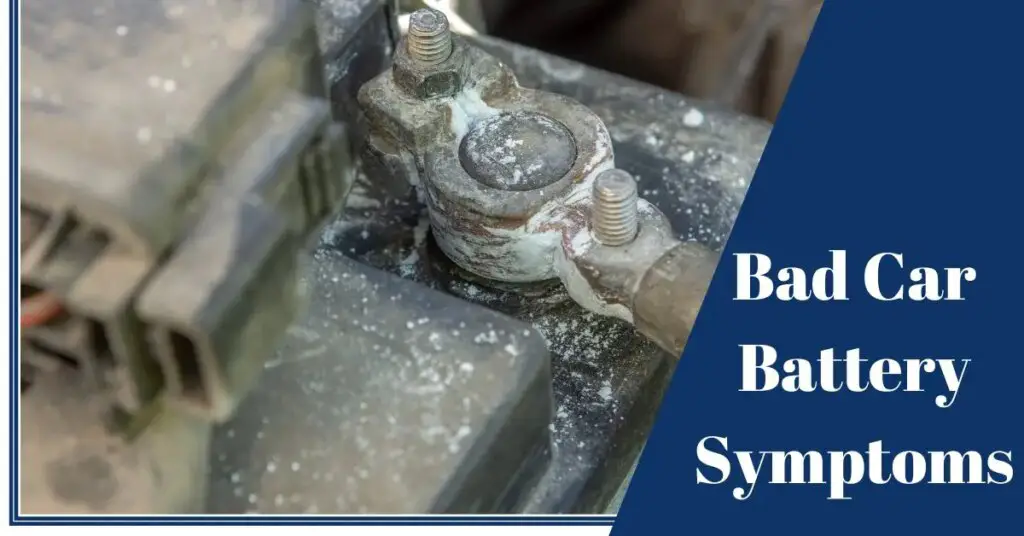Car batteries are the silent powerhouses that keep our vehicles running smoothly. They play a crucial role in providing the electrical energy required to start the engine, power the lights, and operate various electrical components in our cars.
Despite their significance, car batteries are often taken for granted until they fail, leaving us stranded with a non-responsive vehicle.
The purpose of this article is to shed light on the various symptoms of a failing car battery. By understanding these warning signs, car owners can take proactive measures to prevent unexpected breakdowns and ensure the optimal performance of their vehicles.
We will explore the common indicators of a bad car battery, discuss the diagnostic methods, and offer valuable tips to extend battery life. Additionally, we’ll address frequently asked questions to address any concerns or misconceptions regarding car batteries.
So, let’s dive in and learn how to recognize and deal with bad car battery symptoms to stay on the road with confidence.
Table of Contents
What is a Car Battery?
A car battery is a rechargeable energy storage device that supplies electrical power to start the engine and operate various electrical systems in an automobile. It stores chemical energy and converts it into electrical energy, which is essential for the vehicle’s functioning.
Function of a Car Battery
The primary function of a car battery is to provide the initial burst of electrical energy required to start the engine. When you turn the ignition key, the battery sends an electrical current to the starter motor, which cranks the engine and gets it running. Once the engine is running, the alternator takes over and supplies electrical power to the car’s electrical systems while also recharging the battery.
Components of a Car Battery
A typical car battery consists of several key components that work together to store and release electrical energy efficiently:
- Positive and Negative Plates: These are lead plates coated with lead oxide and lead sponge, respectively, and they undergo chemical reactions to store and release energy.
- Electrolyte: It is a mixture of sulfuric acid and water that facilitates the flow of ions between the positive and negative plates.
- Separator: A material that keeps the positive and negative plates from touching each other, preventing short circuits.
- Battery Case: The outer housing that contains all the internal components and protects the battery from damage.
- Terminals: These are the connection points where the battery is linked to the vehicle’s electrical system.
Lifespan of a Typical Car Battery
The lifespan of a car battery depends on various factors, including usage patterns, maintenance, and environmental conditions. On average, a well-maintained car battery can last between three to five years.
However, extreme temperatures, frequent short trips, and high electrical demands can shorten the battery’s life. Regular maintenance and proper care can help extend its lifespan and ensure reliable performance.
7 Common Bad Car Battery Symptoms
1. Dimming Headlights
Dimming headlights are one of the early warning signs of a failing car battery. When you start your vehicle or use electrical components like the radio or air conditioning, and you notice the headlights becoming noticeably dim, it indicates that the battery may be losing its charge. This symptom is especially evident at night or when the engine is idling.
Causes of Dim Headlights:
- Battery is nearing the end of its life and cannot hold a full charge.
- Corroded or loose battery terminals leading to poor electrical connections.
- Electrical system issues causing excessive power drain.
2. Slow Engine Crank
When you try to start your car, and the engine cranks slowly or takes longer than usual to start, it could be a sign of a weak car battery. The cranking speed is a good indicator of the battery’s health, and a slow crank suggests that the battery may not have enough power to turn the engine over effectively.
Factors Affecting Engine Cranking Speed:
- Low battery charge due to extended periods of inactivity.
- Extreme temperatures affecting the battery’s performance.
- Battery terminals covered in corrosion, inhibiting proper electrical flow.
3. Dashboard Warning Lights
Modern vehicles are equipped with sophisticated onboard diagnostics systems that monitor various components, including the battery. If your car’s dashboard warning lights, such as the battery light or check engine light, illuminate or flash, it could indicate a battery problem or issues with the charging system.
Interpreting Warning Lights:
- Battery light: Illuminates when the battery is not charging properly.
- Check engine light: Can indicate various issues, including battery or charging system problems.
4. Electrical Component Malfunctions
A failing car battery can lead to electrical malfunctions in your vehicle’s systems. You may experience issues with power windows, door locks, infotainment system, or interior lights not functioning correctly or erratically.
Explanation of Electrical Issues:
- As the battery weakens, it may not supply enough power to the electrical components.
- Voltage fluctuations due to a dying battery can cause electronic glitches.
5. Unusual Smell
If you notice a sulfurous or rotten egg-like smell coming from the engine bay or the battery itself, it could indicate a battery leak or overcharging. Such odors are a serious warning sign, and immediate attention is necessary.
Identifying Battery-Related Odors:
- A sulfuric smell indicates battery acid leakage, which can damage surrounding components.
- Overcharging the battery can lead to excessive hydrogen gas emission, causing a rotten egg smell.
6. Corrosion on Battery Terminals
Battery terminals that appear crusty, greenish, or corroded can hinder the flow of electricity between the battery and the vehicle’s electrical system. Corrosion on terminals can weaken the connection and affect the battery’s performance.
How Corrosion Occurs and Its Implications:
- Corrosion develops due to chemical reactions between the battery acid and the terminals.
- It can lead to poor electrical contact, hindering the charging and discharging process.
7. Old Age of the Battery
Car batteries have a limited lifespan, and as they age, their performance gradually declines. If your battery is more than three to five years old and you notice any of the above symptoms, it’s likely time for a replacement.
Recognizing When a Battery Needs Replacement Due to Age:
- Keeping track of the battery’s age and maintenance history helps anticipate replacement needs.
- If the battery has served its typical lifespan and shows signs of deterioration, it’s best to get a new one before it fails completely.
Click here to see Customer highly rated car battery on Amazon
Diagnosing a Bad Car Battery
1. Performing a Voltage Test
A voltage test is a simple yet effective way to assess the health of a car battery and determine if it needs replacement or recharging. To perform this test, follow these steps:
Step 1: Ensure the vehicle is turned off, and all electrical components are off.
Step 2: Locate the battery terminals – the positive (+) and negative (-) terminals.
Step 3: Use a digital multimeter and set it to DC voltage.
Step 4: Connect the red (positive) probe of the multimeter to the positive terminal of the battery.
Step 5: Connect the black (negative) probe of the multimeter to the negative terminal of the battery.
Step 6: Read the voltage displayed on the multimeter. A healthy battery should read around 12.6 to 12.8 volts.
Step 7: If the voltage reads significantly lower, it may indicate a weak or discharged battery.
2. Load Testing the Battery
Load testing provides a more in-depth assessment of the battery’s condition under a simulated load. This test helps identify how the battery performs when supplying power to the vehicle’s electrical systems. Follow these steps for load testing:
Step 1: Ensure the battery is fully charged before conducting the test.
Step 2: Use a load tester, available at auto parts stores or repair shops.
Step 3: Turn off the vehicle and connect the load tester to the battery following the manufacturer’s instructions.
Step 4: Apply the load on the battery for about 15 seconds while observing the voltage reading.
Step 5: A healthy battery should maintain a voltage above 9.6 volts during the load test.
Step 6: If the voltage drops significantly below this threshold, the battery may need replacement.
3. Inspecting Battery Case and Terminals
Physical inspection of the battery case and terminals is crucial in determining potential issues with the battery. Follow these steps to inspect the battery:
Step 1: Open the hood and visually examine the battery case for any cracks, bulges, or other physical damage.
Step 2: Check for signs of corrosion on the battery terminals (the metal posts where the battery cables connect).
Step 3: Corrosion appears as white or greenish deposits on the terminals.
Step 4: Ensure the battery terminals are securely attached to the battery posts without any looseness.
Step 5: If you notice any physical damage or heavy corrosion, it may be affecting the battery’s performance and require immediate attention.
Step 6: Clean the terminals if there is mild corrosion using a mixture of baking soda and water and a wire brush. Be cautious and use protective gear when handling battery acid.
Causes of Premature Battery Failure
1. Extreme Temperatures
Extreme temperatures, both hot and cold, can significantly impact the performance and lifespan of car batteries.
Hot Weather
High temperatures can cause the electrolyte in the battery to evaporate, leading to a decreased level of battery acid. This reduces the battery’s ability to hold a charge and accelerates internal corrosion.
In extremely hot conditions, the battery’s internal components can warp or deteriorate, resulting in permanent damage.
Cold Weather
Cold temperatures slow down the chemical reactions within the battery, reducing its ability to deliver sufficient power to start the engine. Additionally, cold weather increases the load on the battery during engine cranking, further straining it.
Prolonged exposure to freezing temperatures can cause the battery to freeze, leading to internal damage and possible rupture.
2. Overcharging
Overcharging occurs when the voltage regulator in the vehicle’s charging system fails, causing excessive charging of the battery. This can lead to several issues:
- Electrolyte Boiling: Overcharging causes the battery’s electrolyte to overheat and evaporate, leading to reduced battery fluid levels and accelerated wear.
- Corrosion: Excessive charging generates excess hydrogen gas within the battery, leading to corrosion on the battery terminals and connections.
- Battery Damage: Prolonged overcharging can damage the battery plates and lead to a shorter lifespan.
- Risk of Explosion: In extreme cases, overcharging can produce flammable hydrogen gas, increasing the risk of a battery explosion.
3. Lack of Maintenance
Regular battery maintenance is essential for its longevity and reliable performance. Neglecting maintenance can result in the following issues:
- Corrosion Buildup: Lack of cleaning and applying protective coatings on battery terminals allows corrosion to build up, hindering the electrical connection.
- Loose Connections: Failing to tighten battery terminals properly can lead to loose connections, causing electrical fluctuations and reduced charging efficiency.
- Insufficient Water Levels: For some types of batteries, such as lead-acid batteries, checking and maintaining proper water levels is essential. Low water levels can lead to irreversible damage to the battery plates.
- Sulfation: Without proper maintenance, lead-acid batteries can develop sulfation, a condition where lead sulfate crystals form on the battery plates, reducing its capacity and performance.
How to Extend Car Battery Life
1. Driving Habits
Your driving habits can significantly impact the lifespan of your car battery.
- Avoid Short Trips: Short trips do not allow the battery to fully recharge, putting additional strain on it. Whenever possible, combine errands into longer trips to give the battery sufficient charging time.
- Turn Off Electrical Accessories: Minimize the use of electrical accessories like air conditioning, radio, and lights when the engine is off or idling. Excessive use of these accessories can drain the battery.
- Park in the Shade: Parking your vehicle in the shade during hot weather helps reduce the temperature around the battery, preventing fluid evaporation and internal damage.
2. Proper Storage
If you plan to store your vehicle for an extended period, taking the following precautions can help preserve the battery:
- Disconnect the Battery: If possible, disconnect the negative terminal of the battery to prevent any electrical drain during storage.
- Use a Battery Maintainer/Trickle Charger: Consider using a battery maintainer or trickle charger to keep the battery charged during storage. These devices provide a slow, steady charge, preventing the battery from discharging.
- Store in a Cool, Dry Place: When storing the vehicle, choose a cool and dry location to minimize temperature fluctuations and prevent damage to the battery.
3. Maintenance Routine
Regular maintenance is vital for extending the life of your car battery. Create a maintenance schedule and follow these steps:
- Clean Battery Terminals: Periodically check the battery terminals for corrosion. Use a mixture of baking soda and water to clean any buildup, and ensure the connections are tight.
- Check Battery Fluid Levels: For batteries with removable caps, inspect and maintain the proper fluid levels. Add distilled water if needed, but do not overfill.
- Inspect for Physical Damage: Regularly inspect the battery case for cracks, bulges, or other signs of physical damage. If you notice any issues, consider replacing the battery.
- Test the Battery’s Health: Conduct regular voltage tests and load tests to gauge the battery’s health. This can help you identify any issues early and take appropriate action.
- Keep the Battery Secure: Ensure the battery is securely held in place to prevent vibration-related damage.
Frequently Asked Questions
1. How often should I check my car battery’s health?
It’s a good idea to check your car battery’s health at least twice a year, ideally before the extreme temperatures of summer and winter. Regularly inspecting the battery can help identify potential issues early and prevent unexpected breakdowns.
2. Can a bad alternator mimic bad battery symptoms?
Yes, a failing alternator can produce symptoms similar to those of a bad battery. A faulty alternator may not effectively charge the battery while the engine is running, leading to dimming headlights, slow engine cranking, and other battery-related symptoms.
3. Can I jump-start my car with a bad battery?
Yes, you can jump-start your car with a bad battery, but keep in mind that jump-starting is a temporary solution. The vehicle might start, but it may not run properly or might stall again if the battery is severely discharged or damaged.
4. How long does a car battery typically last?
The lifespan of a car battery varies depending on factors such as usage patterns, maintenance, and environmental conditions. On average, a well-maintained car battery can last between three to five years.
5. Can a car battery suddenly die without warning?
Yes, a car battery can sometimes fail suddenly without warning, especially if it has been subjected to extreme conditions or has reached the end of its lifespan. However, more often, there are warning signs like dimming headlights or slow engine cranking.
6. What is the average cost of replacing a car battery?
The cost of replacing a car battery depends on various factors, including the type of battery and the make and model of the vehicle. On average, a standard car battery replacement can cost anywhere from $100 to $300.
7. Are there any eco-friendly car battery options available?
Yes, there are eco-friendly car battery options available, such as AGM (Absorbent Glass Mat) batteries and lithium-ion batteries. These batteries are designed to be more energy-efficient and have less environmental impact than traditional lead-acid batteries.
8. Can a bad battery damage other car components?
Yes, a bad battery can potentially damage other car components. For example, a weak battery may cause the alternator to work harder, leading to premature alternator failure. Additionally, a battery leak can corrode nearby components.
9. How can extreme weather affect my car battery?
Extreme temperatures, both hot and cold, can affect the performance and lifespan of a car battery. Hot weather can accelerate evaporation of battery fluid, while cold weather can reduce the battery’s cranking power and increase the load during engine start-up.
10. Are there any DIY methods to revive a dead battery?
While there are some DIY methods to try and revive a dead battery, they are not always reliable and may not work in all cases. Some methods include using Epsom salt or a battery desulfator, but it’s best to seek professional assistance or replace the battery if it’s beyond repair.
In conclusion, recognizing bad car battery symptoms is of utmost importance for every vehicle owner. By being aware of these warning signs, you can take proactive measures to prevent unexpected breakdowns and ensure the optimal performance of your car.
Dimming headlights, slow engine cranking, warning lights, and electrical malfunctions are all red flags that should not be ignored.
Regular maintenance plays a significant role in extending the life of your car battery. Following a simple maintenance routine, such as checking battery terminals, monitoring fluid levels, and conducting voltage tests, can go a long way in keeping your battery in top condition.
Early diagnosis of battery issues is crucial. Conducting voltage tests and load tests can help you identify potential problems before they escalate, saving you from the inconvenience and expenses of a sudden battery failure.
If you suspect any battery-related problems or encounter persistent symptoms, don’t hesitate to seek professional help. Experienced mechanics can perform thorough diagnostics and suggest the best course of action, be it battery replacement or other repairs.
By being proactive, maintaining your battery properly, and seeking professional help when needed, you can enjoy a reliable and long-lasting car battery that keeps you on the road with confidence.
Remember, a healthy car battery is not just essential for your vehicle’s operation but also for your peace of mind as a responsible driver.
Click here to see Customer highly rated car battery on Amazon
Hi there! I’m Naomi O’Colman. I’ve got years of experience working at an auto repair shop here in Texas under my belt. On top of that, ever since I was a kid I’ve been passionate about the auto industry. Since I’ve joined the team at automotivegearz.com I’ve been enthusiastically sharing my passion and insights with my readers. I’m dedicated to delivering high quality content and helping you stay up to date with the latest automotive trends and products out there!







